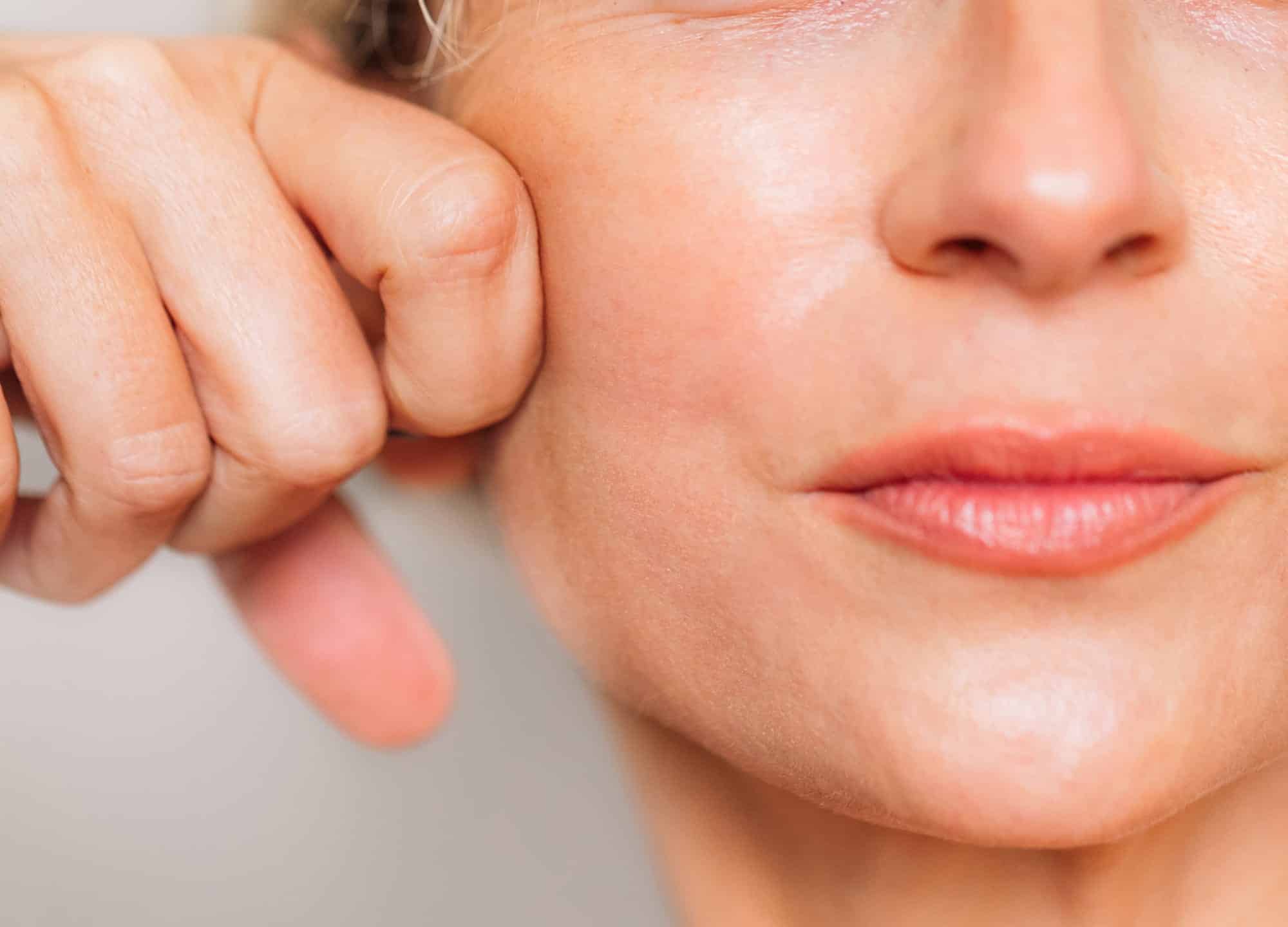Jowls—even the name of this inevitable result of the aging process sounds unappealing. “Jowls consist of the loose skin and underlying tissue that sags and sits below the jawline,” explains Dr. Jaimie DeRosa, a board-certified facial plastic surgeon in Boston. “By and large, jowl formation is going to happen to everyone eventually,” she notes; credit the fact that they are caused by a combination of both internal and external factors.
As far as intrinsic aging goes, there are a variety of anatomical issues at play (which is part of what makes them tricky to treat, but more on that point in a moment). The mandibular ligaments in the jaw become more lax and coupled with skin that becomes thinner with age, leads to a protrusion of the underlying fat pads, creating the look of unwanted fullness, explains Dr. Amaka Nwubah, a board-certified plastic surgeon in Franklin, Tennessee. We also naturally lose volume and subcutaneous age as we fat, causing the skin to further sag, adds New York City board-certified plastic surgeon Dr. David Shafer. “It’s like letting the air out of a balloon and going from a tight, smooth surface to one that no longer holds its shape,” he explains.
In general, people tend to notice signs of jowling in their late 40s or early 50s, according to Dr. DeRosa—and certain things can make you more predisposed to this issue. “People who have thin jawlines may develop jowls sooner than those with large, strong jawlines. When the underlying framework is smaller, the outer covering—the skin and tissue—tend to fall more easily instead of being held in place, the way they are by a larger jawline,” she explains. Those who’ve experienced dramatic weight fluctuations may also develop them earlier, as their skin tends to be more stretched out. Finally, any type of external factor that damages collagen and elastin—smoking and sun exposure being the big ones—will also accelerate jowling. “The breakdown of collagen and elastin leaves the skin less tight and toned, further accentuating the appearance of jowls,” Dr. Nwubah points out.
What can be done to get rid of jowls—or, at the very least, minimize their appearance? According to the doctors we spoke with, a facelift is undoubtedly the gold standard. However, there are other, nonsurgical options that can help. Here, more on the four best treatments for jowls, from least to most invasive.
Injectable filler
Hyaluronic acid–based filler can help minimize the look of jowls in several different ways. It can provide volume in the area of the jawbone, counteracting the loss of volume that occurs in the underlying bony structure and creating the appearance of a stronger jawline, says Dr. DeRosa. Similarly, it can be injected both behind and in front of the jowls, closer to the chin, in order to camouflage them and make the jawline appear straighter and more youthful, says Dr. Shafer, who likes the new Juvéderm Volux for this reason. Filler can also be injected into the cheeks for more of a lifting effect, where it will subtly pull the skin upward and help minimize the look of jowls in the process, he adds. Either way, expect the results to last from between 12 and 18 months, depending on the exact product used.
Energy-based treatments
Ultherapy (which uses ultrasound energy) or treatments that rely on radiofrequency energy, such as Morpheus8 (RF microneedling) or FaceTite, are other minimally invasive choices. “These work to tighten the skin overlying the jowl, although they’re not long-lasting treatments because they’re not technically treating the source of the jowling itself,” notes Dr. Nwubah. Rather, by treating and improving the quality of the skin, you’re camouflaging the jowling effect, she explains. Dr. Shafer agrees, noting that these are best for those who are just starting to notice signs of jowling and need only slight tightening rather than patients with very prominent laxity or drooping. He adds that two or three treatments, six to eight weeks apart, are typically needed, followed by annual maintenance sessions.
PDO thread lift
“PDO threads may also help treat jowls. They work by pulling the underlying tissue upward, taking weight off the jawline and reducing jowling,” says Dr. DeRosa. Again, this is best suited for those with very mild laxity. The threads are not going to work for those with heavy jowls, and it will also be harder to achieve visible results on someone who has very thick skin, she points out. Again, the results aren’t permanent, lasting only about 6 to 12 months.
Facelift
At the end of the day, surgery really is the most effective option for treating significant jowling, and it will deliver results that are as close to permanent as you can get (because nothing can stop the aging process). “A facelift is the best and most durable treatment for jowls because it treats the source of the issue, the weakened ligament. These ligaments are not only released—they’re also pulled tight and any excess fat in the area can also be removed,” Dr. Nwubah explains. Excess skin can also be removed and/or tightened during a facelift, adds Dr. Shafer. In short, this is the only treatment option that addresses all the various anatomical components at play.
The bottom line
“Patients need to understand the difference between improving, minimizing, reducing, and eliminating,” notes Dr. Shafer. This holds true when it comes to any kind of cosmetic issue but perhaps even more so when it comes to jowling, which really can’t be addressed via a cookie-cutter approach, he notes. Results are always going to vary based on the extent of the jowling and the treatment chosen—there’s no “one size fits all” solution. It’s also important to keep in mind that jowls occur on just one part of the face. Finding a doctor who has a discerning eye and can do a full facial assessment—and is skilled in multiple types of treatments—is ultimately what will yield the best and most natural end result, Dr. Shafer points out.











